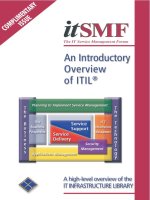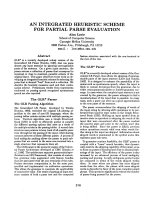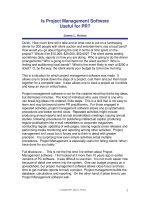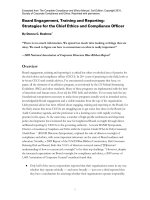Integrated reporting useful for investors
Bạn đang xem bản rút gọn của tài liệu. Xem và tải ngay bản đầy đủ của tài liệu tại đây (3.47 MB, 328 trang )
IUR
Münsteraner Schriften
zur Internationalen Unternehmensrechnung
Herausgegeben von Peter Kajüter
Stefan Hannen
Integrated Reporting
Useful for investors?
Band 15
Integrated Reporting
MÜNSTERANER SCHRIFTEN ZUR
INTERNATIONALEN
UNTERNEHMENSRECHNUNG
Herausgegeben von Peter Kajüter
Band 15
Zu Qualitätssicherung und Peer
Review der vorliegenden Publikation
Die Qualität der in dieser Reihe
erscheinenden Arbeiten wird vor
der Publikation durch den
Herausgeber der Reihe geprüft.
Notes on the quality assurance and
peer review of this publication
Prior to publication, the quality
of the work published in this
series is reviewed by
the editor of the series.
Stefan Hannen
Integrated Reporting
Useful for investors?
Bibliographic Information published by the Deutsche Nationalbibliothek
The Deutsche Nationalbibliothek lists this publication in the Deutsche
Nationalbibliografie; detailed bibliographic data is available in the internet
at .
Zugl.: Münster (Westfalen), Univ., Diss., 2016
Library of Congress Cataloging-in-Publication Data
A CIP catalog record for this book has been applied
for at the Library of Congress
D6
ISSN 1868-7687
ISBN 978-3-631-73247-2 (Print)
E-ISBN 978-3-631-73323-3 (E-PDF)
E-ISBN 978-3-631-73324-0 (EPUB)
E-ISBN 978-3-631-73325-7 (MOBI)
DOI 10.3726/b11722
© Peter Lang GmbH
Internationaler Verlag der Wissenschaften
Frankfurt am Main 2017
All rights reserved.
PL Academic Research is an Imprint of Peter Lang GmbH.
Peter Lang – Frankfurt am Main ∙ Bern ∙ Bruxelles ∙ New York ∙
Oxford ∙ Warszawa ∙ Wien
All parts of this publication are protected by copyright. Any
utilisation outside the strict limits of the copyright law, without
the permission of the publisher, is forbidden and liable to
prosecution. This applies in particular to reproductions,
translations, microfilming, and storage and processing in
electronic retrieval systems.
This publication has been peer reviewed.
www.peterlang.com
Preface
V
Preface
Integrated Reporting intends to address current deficiencies of corporate reporting practice
– in particular information overload, redundancies and poor readability. Improvements in
corporate reporting are of interest for investors, the primary addressees of corporate reports,
as it may have consequences for their investment decisions. By promoting Integrated Reporting and by developing the International <IR> Framework, the International Integrated
Reporting Council made a considerable effort aiming at improving corporate reporting.
However, this new holistic approach to corporate reporting raises a number of questions.
This thesis deals with several of these issues, analyzing whether Integrated Reporting can
achieve its objective to provide useful information for investors’ decision-making. From a
conceptual perspective, Stefan Hannen investigates if the IIRC’s International <IR> Framework offers a suitable basis for the preparation of decision-useful reports. Moreover, the
study takes a look at the practice of Integrated Reporting. Using content analysis, it examines reports in South Africa and the USA at two different points in time. Thus, this thesis
documents in how far the Integrated Reporting principles had already been present in “conventional” annual reports and in how far the introduction of a quasi-obligation for firms to
engage in Integrated Reporting, as in South Africa, changed this situation. In addition,
Stefan Hannen investigates potential consequences of Integrated Reporting for the capital
market. The study examines whether this reporting format possibly moderates an existing
investor underreaction to the release of a firm’s report.
These findings support the assertion that Integrated Reporting may make a difference for
the corporate reporting landscape. Conceptually speaking, the International <IR> Framework introduces a useful set of requirements for firms’ reports to support investors’ decisions. From the empirical perspective, the descriptive study shows that reports prepared
under the quasi-obligation to implement Integrated Reporting indeed yield (innovative)
features that traditional reports do not exhibit. In addition, the capital-market study reveals
a negative association between the degree of Integrated Reporting in firms’ reports and investor underreaction following the report release.
The study contributes to the young field of literature on Integrated Reporting in several
ways. In addition to providing a thorough conceptual analysis from an investor’s perspective, it supplements existing research on Integrated Reporting practice, extending the range
of countries examined in the literature and drawing on a solid research design. Furthermore,
the capital market study contributes to the field of impact studies on Integrated Reporting
while connecting this field with research on other topics such as investor underreaction.
The results yield several implications, most importantly for investors. However, the study
also discusses potential implications for other parties like the reporting firms or regulators.
Considering these contributions as well as the rigor of the study and the great topicality of
Integrated Reporting, I am convinced that this thesis will draw a lot of attention and will
be popular among academics and practitioners alike.
Münster, May 2017
Prof. Dr. Peter Kajüter
Acknowledgment
VII
Acknowledgment
I have conducted this study during my time at the Chair of International Accounting at the
University of Münster. The School of Business and Economics accepted this thesis as a
dissertation in September 2016.
In this acknowledgment I want to express my gratitude for all the support I have received.
First, I would like to thank my academic teacher and supervisor Prof. Dr. Peter Kajüter.
Since I was a student in the bachelor’s program I have been affiliated to his chair in many
ways. During all these years he gave me support and encouragement, both before and during
my work on the thesis. His critical thinking, high standard of demands and constructive
comments and suggestions provided a fruitful basis for my work and improved my thesis
considerably. Moreover, I want to thank Prof. Dr. Hans-Jürgen Kirsch and Prof. Dr. Bernd
Kempa, the members of the review committee.
Likewise, I want to pay tribute to my companions at the chair. In addition to supporting
me with professional advice, our great team gave me a lot of unforgettable memories. Many
of these are captured in the unbelievable doctoral cap that my colleagues made for me. A
special thanks goes to Dr. Martin Nienhaus who I have been sharing an office with for
almost two years. The discussions with Martin about my work were of immeasurable value.
Moreover, I enjoyed spending time with him outside the university, with sports, barbecues,
and other activities that made us forget our work for a while. Many thanks also to Stephanie
Eckerth, particularly for her feedback on my thesis, her hospitality and for all the great talks
that we had, especially during the innumerable car drives between Münster and Düsseldorf.
I also owe thanks to Matthias Nienaber. Besides receiving his feedback on my thesis, I enjoyed developing creative ideas with him, on the chair’s PR work and beyond, which resulted in countless pieces of “art”. I particularly appreciate the help of Florian Klassmann,
whose thorough and constructive feedback on my study considerably improved my work.
So did the remarks of Friedrich Kalden, who never failed to enrich both professional and
private conversations with his cunning comments, as well as the feedback and assistance I
received from Henrik Schirmacher. Henrik also appeared to be an excellent host, providing
me a place to sleep in the apartment I used to live in before him.
Another dear colleague I had the pleasure to share my office with was Dr. Gregor Hagemann. Not only were we members of the same team at the chair, but we also sported the
same colors in our soccer team, thus celebrating victories together on multiple levels. Furthermore, I would like to thank Alexander Schulz for the great collaboration in organizing
various rounds of our annual sailing seminar. I bet we could easily run a travel agency for
sailing trips together if we ever found ourselves fed up with our regular jobs. In this regard,
I also want to mention Dr. Daniel Blaesing. He was (and still is) a great co-author and
sports buddy, as well as a dear colleague, neighbor, and friend. The same holds true for
Daniel’s now-wife Christina Blaesing-Voets. Thank you very much also to my “veteran”
colleagues Dr. Maximilian Saucke, Dr. Moritz Schröder and Marcel Baki, who not only
helped me during my time at the chair, but were always committed to supporting our team
as a whole in a multitude of ways. In addition, they are really nice and funny people. So are
all my younger colleagues, namely Daniela Peters, Max Meinhövel, Kai Schaumann and
Martin Vogelpohl, who continue to show the same commitment to our invaluable team.
VIII
Acknowledgment
I am also very thankful to all other fellow research assistants that made my time at the chair
unforgettable, namely Dr. Kristian Bachert, Dr. Thomas Blades, Julius Hannemann, Charlotte Kaiser, Dr. Martin Merschdorf, Dr. Matthias Moeschler and Tobias Stadtbäumer. In
addition, I would like to mention our student assistants who kept things ticking at the chair
and supported us in so many ways. In particular, I want to highlight the work of Robert
Beukmann, Johannes Effenberger, Manuel Herkenhoff and Nils Nürnberg, who were of
major assistance during different phases of my study. Finally, I would like to show my gratitude for our colleagues in the secretary’s office, Ashly Bills, Tobias Langehaneberg and Leila
Prousch, who were always there to guide me through the university’s administrative jungle.
Beyond the chair, I am also very thankful for the dear friends I have got to know in Münster.
We had a great time with many unforgettable experiences, but I am more than glad that
our friendship did not end with our time in the Westphalian metropolis. Instead, we still
manage to spend time together as often as possible (e.g., at our annual Christmas party or
on vacation), even though we live in different places all over the world. The same holds for
those friends that have been by my side since I went to school or even before. Some of you
also spent your studies in Münster, and some have also faced, or are still facing, the challenge
of writing doctoral theses on a variety of different topics. It is always a pleasure to exchange
our views on these and other topics over a couple of beers, to indulge in memories of the
good old times, or to simply fool around. I could not imagine a better group of friends.
Most importantly, however, I want to express my gratitude to my family, in particular to
my parents Ursula and Peter Hannen. You have been there for me during my entire life and
have enabled me to become the person I am today, backing me in whatever I wanted to do.
Thank you so much for this unconditional support, and most of all for your love. But my
parents would not have been able to do so without the help of my grandparents, Maria and
Josef Hannen and especially Käthe and Walter Schmidt. In particular, I want to address the
influence of my grandfather Walter. You taught me the value of being curious by exploring
my surroundings with me when I was a child and setting the example of how important it
is to never stop learning. You gave me the mindset that enabled me to conduct this study.
So I dedicate this thesis to you. I also want to mention my brother Andreas, my sister
Katharina and her boyfriend Nils, as well as my parents-in-law Angelika Banik-Bürger and
Michael Bürger, my brothers-in-law Max and Christoph, my sister-in-law Alexandra and
her boyfriend Philipp as well as my godfather Hans Stenert and his wife Sylvia. Thank you
for your patience, as almost all of our conversations over the last years reflected my study.
Eventually, I want to say thank you to my beloved wife Kathi. I am so grateful that you
never lost faith in me no matter how tough my work was, nor how strenuous it could be
for myself and for us as a couple. Not only did you tolerate my strange ideas and work
habits, but you became involved with my research itself, from discussing my thoughts to
proofreading the thesis along the way. After these years, I cannot wait for my future with
you, when I can finally redirect the dedication I have spent on my thesis to all the things
that really count in our life. Nobody deserves this more than you.
Münster, May 2017
Stefan Hannen
Contents overview
IX
Contents overview
1
Introduction ................................................................................................ 1
1.1 Motivation and objective of the study ............................................................. 1
1.2 Scientific research strategy .............................................................................. 9
1.3 Outline of the study...................................................................................... 11
2
The Integrated Reporting approach ............................................................. 14
2.1 History and institutional background ........................................................... 14
2.2 The International <IR> Framework .............................................................. 19
2.3 Critical discussion of the Framework ............................................................ 33
3
Corporate reporting in South Africa and the USA ........................................ 56
3.1 Corporate reporting in South Africa ............................................................. 56
3.2 Corporate reporting in the USA ................................................................... 71
4
Integrated Reporting in practice .................................................................. 92
4.1 State of research ............................................................................................ 92
4.2 Theory and hypotheses development .......................................................... 106
4.3 Methodology .............................................................................................. 113
4.4 Results ........................................................................................................ 128
4.5 Discussion .................................................................................................. 151
5
Capital market consequences of Integrated Reporting ................................ 155
5.1 State of research .......................................................................................... 155
5.2 Theory and hypothesis development ........................................................... 164
5.3 Methodology .............................................................................................. 171
5.4 Results ........................................................................................................ 181
5.5 Discussion .................................................................................................. 209
6
Summary and conclusions ......................................................................... 213
6.1 Summary of the conceptual and the empirical analysis................................ 213
6.2 Implications ................................................................................................ 221
6.3 Limitations and outlook ............................................................................. 223
Contents
XI
Contents
List of figures ............................................................................................... XV
List of tables .............................................................................................. XVII
List of abbreviations .................................................................................... XIX
List of symbols ........................................................................................ XXVII
1
Introduction ............................................................................................ 1
1.1 Motivation and objective of the study ........................................................ 1
1.2 Scientific research strategy ......................................................................... 9
1.3 Outline of the study................................................................................. 11
2
The Integrated Reporting approach ......................................................... 14
2.1 History and institutional background ...................................................... 14
2.2 The International <IR> Framework ......................................................... 19
2.2.1 Overview of basic characteristics of IR, the IR Framework
and its use ..................................................................................... 20
2.2.2 Fundamental Concepts ................................................................. 21
2.2.3 Guiding Principles ........................................................................ 24
2.2.4 Content Elements ......................................................................... 29
2.3 Critical discussion of the Framework ....................................................... 33
2.3.1 The purpose of an integrated report .............................................. 34
2.3.2 Guiding Principles ........................................................................ 41
2.3.3 Content Elements ......................................................................... 49
3
Corporate reporting in South Africa and the USA .................................... 56
3.1 Corporate reporting in South Africa ........................................................ 56
3.1.1 Economic and historical background ............................................ 57
3.1.2 Institutions regulating corporate reporting .................................... 58
3.1.3 Regulations on corporate reporting ............................................... 61
3.1.4 Summary of the South African reporting landscape ...................... 71
3.2 Corporate reporting in the USA .............................................................. 71
3.2.1 Economic and historical background ............................................ 72
3.2.2 Institutions regulating corporate reporting .................................... 74
3.2.3 Regulations on corporate reporting ............................................... 76
XII
Contents
3.2.4 Summary of the US reporting landscape ....................................... 89
4
Integrated Reporting in practice ............................................................. 92
4.1 State of research ....................................................................................... 92
4.2 Theory and hypotheses development ..................................................... 106
4.2.1 Principal Agent Theory ............................................................... 106
4.2.2 Positive Accounting Theory ........................................................ 108
4.2.3 Systems-oriented theories ............................................................ 109
4.2.4 Hypotheses development ............................................................ 111
4.3 Methodology ......................................................................................... 113
4.3.1 Sample ........................................................................................ 114
4.3.2 Content analysis catalogue .......................................................... 120
4.3.2.1
Content analysis .......................................................... 120
4.3.2.2
Elements of the catalogue ............................................ 121
4.3.2.3
Data collection and scoring ......................................... 123
4.4 Results ................................................................................................... 128
4.4.1 Basic characteristics of the reports ............................................... 128
4.4.2 The degree of Integrated Reporting ............................................ 130
4.4.2.1
Total Integrated Reporting score ................................. 130
4.4.2.2
Sub-scores on the Guiding Principles .......................... 136
4.4.3 Supplementary measures ............................................................. 145
4.4.4 Summary of the results ............................................................... 150
4.5 Discussion ............................................................................................. 151
5
Capital market consequences of Integrated Reporting ............................ 155
5.1 State of research ..................................................................................... 155
5.2 Theory and hypothesis development ...................................................... 164
5.2.1 The investor underreaction effect ................................................ 164
5.2.2 Moderation of investor underreaction by Integrated Reporting .. 166
5.2.3 Hypothesis development ............................................................. 171
5.3 Methodology ......................................................................................... 171
5.3.1 Regression models ....................................................................... 172
5.3.2 Variables ..................................................................................... 175
5.3.3 Assumptions of the OLS regressions ........................................... 180
Contents
XIII
5.4 Results ................................................................................................... 181
5.4.1 Univariate and bivariate analyses ................................................. 182
5.4.2 Regression analysis ...................................................................... 190
5.4.2.1
Basic model: the investor underreaction effect ............. 190
5.4.2.2
Moderation of the investor underreaction effect by IR 193
5.4.2.3
Robustness tests ........................................................... 196
5.5 Discussion ............................................................................................. 209
6
Summary and conclusions ..................................................................... 213
6.1 Summary of the conceptual and the empirical analysis........................... 213
6.2 Implications ........................................................................................... 221
6.3 Limitations and outlook ........................................................................ 223
Appendix .................................................................................................... 227
Web appendix ............................................................................................. 235
Bibliography ................................................................................................ 237
List of cited annual (integrated) reports ........................................................ 285
List of cited laws, regulations, standards and guidance materials .................... 287
List of figures
XV
List of figures
Figure 1-1: Components of S&P 500 market value ................................................... 3
Figure 1-2: Conception of the study .......................................................................... 7
Figure 1-3: Outline of the study .............................................................................. 13
Figure 2-1: The development of the IR F – major milestones .................................. 15
Figure 2-2: Structure of the IIRC ............................................................................ 17
Figure 2-3: The value creation process ..................................................................... 23
Figure 2-4: Guiding Principles and Content Elements of IR ................................... 24
Figure 2-5: Determining materiality ........................................................................ 26
Figure 2-6: Three-step cascade system of the critical discussion ............................... 34
Figure 2-7: The purpose of an integrated report ...................................................... 35
Figure 2-8: The Octopus Model .............................................................................. 36
Figure 2-9: Three dimensions of connectivity .......................................................... 44
Figure 2-10: Relationships between the IR Content Elements ................................... 50
Figure 2-11: Risks and opportunities ......................................................................... 52
Figure 3-1: Reporting principles under the IRCSA DP and Guiding Principles
under the IR F ....................................................................................... 67
Figure 3-2: Report contents under the IRCSA DP and Content Elements
under the IR F ....................................................................................... 70
Figure 3-3: Qualitative Characteristics under the CF and Guiding Principles
under the IR F ....................................................................................... 79
Figure 3-4: Items of Form 10-K and Content Elements under the IR F .................. 82
Figure 4-1: Studies on IR practice – Global coverage ............................................... 95
Figure 4-2: The relationship of the study at hand to extant empirical literature
on IR practice ...................................................................................... 105
Figure 4-3: Three hypotheses of Positive Accounting Theory ................................ 108
Figure 4-4: Overview of systems-oriented theories ................................................. 109
Figure 4-5: Setting of the study ............................................................................. 114
Figure 4-6: Industry distribution of the sample firms............................................. 117
Figure 4-7: Supplementary measures ..................................................................... 126
Figure 4-8: Boxplots of the IR score and sub-scores ............................................... 131
Figure 4-9: Example STAKE: Sasol (RSA 2012) .................................................... 140
XVI
List of figures
Figure 4-10: Mean number of links and references in the report ............................. 143
Figure 4-11: Example COMP2: DIRECTV (USA 2012) ....................................... 145
Figure 4-12: Results for H1.1 .................................................................................... 152
Figure 4-13: Results for H1.2 .................................................................................... 153
Figure 4-14: Results for H1.3 .................................................................................... 154
Figure 4-15: Results for H1.4 .................................................................................... 154
Figure 5-1: Underreaction to good and bad news at the stock market ................... 161
Figure 5-2: The relationship of the study at hand to extant empirical literature
on economic conse-quences of IR and other market impacts .............. 164
Figure 5-3: Rational expectations assumptions and explanations that relax these
assumptions ........................................................................................ 165
Figure 5-4: Cognitive Load Theory ....................................................................... 168
Figure 5-5: Pragmatics – Basic definitions ............................................................. 169
Figure 5-6: Pragmatics – Principles and Maxims of Conversation ......................... 170
Figure 5-7: Three models to analyze the moderation of investor underreaction
by IR ................................................................................................... 173
Figure 5-8: Cumulative abnormal returns relative to the release of the annual
(integrated) report ............................................................................... 182
Figure 5-9: Overview of the results ........................................................................ 209
Figure 5-10: Results for H2 ...................................................................................... 212
List of tables
XVII
List of tables
Table 3-1:
Overview of reporting regulations in South Africa ................................. 61
Table 3-2:
Overview of reporting regulations in the USA ....................................... 78
Table 3-3:
IR F coverage by South African and US regulations .............................. 91
Table 4-1:
Overview of agency problems and their possible mitigations ............... 107
Table 4-2:
Sample selection process ...................................................................... 116
Table 4-3:
Fundamental characteristics of the sample firms .................................. 119
Table 4-4:
General structure of the content analysis catalogue .............................. 122
Table 4-5:
Basic characteristics of the sample reports ............................................ 128
Table 4-6:
Descriptive statistics of the IR score and sub-scores ............................. 132
Table 4-7:
Comparison of the IR score and sub-scores ......................................... 134
Table 4-8:
Descriptive statistics of the differences in the IR score and sub-scores
over time ............................................................................................. 135
Table 4-9:
Comparison of the differences in the IR score and sub-scores .............. 136
Table 4-10: Descriptive statistics of the supplementary measures............................ 146
Table 4-11: Comparison of the supplementary measures ........................................ 148
Table 4-12: Descriptive statistics of the differences over time in the supplementary
measures .............................................................................................. 149
Table 4-13: Comparison of the differences in the supplementary measures ............ 150
Table 4-14: Overview of the differences in the mean IR scores ............................... 152
Table 5-1:
Descriptive statistics of the returns and the control variables ............... 184
Table 5-2:
Matrix of pairwise Pearson and Spearman correlations for the market
response variables, IR score and control variables ................................ 187
Table 5-3:
Matrix of pairwise Pearson and Spearman correlations for the market
response variables, IR scores and the supplementary measures ............ 188
Table 5-4:
Regressions investor underreaction – Testing for the PEAD
and the accrual anomaly ...................................................................... 191
Table 5-5:
Regressions underreaction – Testing for a pseudo release date ............. 192
Table 5-6:
Regressions moderation of the underreaction by IR
(estimation window of 30 days) ........................................................... 193
Table 5-7:
Regressions moderation of the underreaction by IR
(estimation window of 60 days) ........................................................... 195
XVIII
List of tables
Table 5-8:
Aggregated regression results for the moderation of the underreaction
(IR score, total sample) ....................................................................... 196
Table 5-9:
Aggregated regression results for the moderation of the underreaction
(IR score, South Africa)....................................................................... 197
Table 5-10: Aggregated regression results for the moderation of the underreaction
(IR score, USA) ................................................................................... 198
Table 5-11: Aggregated regression results for the moderation of the underreaction
(CONX sub-score, total sample) ......................................................... 199
Table 5-12: Aggregated regression results for the moderation of the underreaction
(alternative IR score 1, total sample) ................................................... 201
Table 5-13: Aggregated regression results for the moderation of the underreaction
(alternative IR score 2, total sample) ................................................... 202
Table 5-14: Aggregated regression results for the moderation of the underreaction
(report length, total sample) ................................................................ 203
Table 5-15: Aggregated regression results for the moderation of the underreaction
(use of boilerplate disclosures, total sample) ........................................ 204
Table 5-16: Aggregated regression results for the moderation of the underreaction
(use of jargon, total sample) ................................................................ 205
Table 5-17: Aggregated regression results for the moderation of the underreaction
(readability, total sample) .................................................................... 206
Table 5-18: Aggregated regression results for the moderation of the underreaction
(IR score vs. report length, total sample) ............................................. 208
List of abbreviations
XIX
List of abbreviations
A4S
ACCA
ACFA
AECI
AFGRI
AIA
AICPA
AIR
AKEU
AKIW
ANC
APB
AS
ASC
ASCG
ASISA
ASR
ASX
AT
AU
BaFin
Accounting for Sustainability (project initiated by HRH
The Prince of Wales)
Association of Chartered Certified Accountants
Annual Conference on Finance and Accounting
AECI Limited (formerly “African Explosives and Chemical
Industries”)
AFGRI Limited
American Institute of Accountants
American Institute of Certified Public Accountants
Annual (integrated) report
Arbeitskreis Externe Unternehmensrechnung der Schmalenbach Gesellschaft für Betriebswirtschaft e.V.
Arbeitskreis “Immaterielle Werte im Rechnungswesen” der
Schmalenbach-Gesellschaft für Betriebswirtschaft e.V.
African National Congress
Accounting Practices Board
Auditing Standard(s) (PCAOB)
Accounting Standards Codification
Accounting Standards Committee of Germany
Association for Saving & Investment South Africa
Accounting Series Release(s)
Australian Securities Exchange
Attestation Standard(s) (AICPA)
Auditing Standard(s) (AICPA)
BC
BEE
BIS
BP
BUSA
Bundesanstalt für Finanzdienstleistungsaufsicht (Federal
Financial Supervisory Authority)
BASF SE (formerly “Badische Anilin und Soda Fabrik” –
Baden Aniline and Soda Factory)
Basis for Conclusion
Black Economic Empowerment
Department for Business Innovation & Skills
BP plc (formerly “British Petroleum”)
Business Unity South Africa
CA
CA ANZ
CAP
California
Chartered Accountants Australia and New Zealand
Committee on Accounting Procedure
BASF
XX
CD IR
CEO
Cf.
CF
CFR
Chemserve
CIMA
CIS
CLP
CLT
CO2
CON
CPA
CSR
CSSA
CT
DAX
D.C.
Dec
DP IR
Dr.
DRS
Ed.
EDGAR
E-DRS
E.g.
Eds.
EITF
EMH
ESG
Et al.
Etc.
e.V.
EVA®
List of abbreviations
Consultation Draft Integrated Reporting (“Consultation
Draft of the International <IR> Framework”)
Chief Executive Officer
Confer
Conceptual Framework for Financial Reporting
Code of Federal Regulations
Chemical Services Limited
Chartered Institute of Management Accountants
Chartered Institute of Secretaries and Administrators
CLP Group (formerly “China Light & Power Company”)
Cognitive Load Theory
Carbon dioxide
Contrary to expectations
Certified Public Accountant
Corporate Social Responsibility
Chartered Secretaries Southern Africa
Connecticut
Deutscher Aktienindex (German Stock Index)
District of Columbia
December
Discussion Paper Integrated Reporting (“Towards Integrated Reporting – Communicating Value in the 21st Century”)
Doctor
Deutscher Rechnungslegungs Standard (German Accounting Standard)
Editor
Electronic Data Gathering, Analysis, and Retrieval
Entwurf Deutscher Rechnungslegungs Standard (Draft
German Accounting Standard)
Exempli gratia (for example)
Editors
Emerging Issues Task Force
Efficient Market Hypothesis
Environmental, social and governance
Et alii
Et cetera
Eingetragener Verein (registered association)
Economic Value Added
List of abbreviations
XXI
EY
Ernst & Young (accounting network)
FAQ
FASB
FRSC
FSB
FTSE
FY
Frequently Asked Questions
Financial Accounting Standards Board
Financial Reporting Standards Council
Financial Services Board
Financial Times Stock Exchange
Financial year
GA
GAAP
GAS
GASB
GDP
GHG
GICS
GRI
GWh
Georgia
Generally Accepted Accounting Principles
German Accounting Standard
Governmental Accounting Standards Board
Gross Domestic Product
Greenhouse gas
Global Industry Classification Code
Global Reporting Initiative
Gigawatt hour(s)
HGB
HR
HRH
http
Handelsgesetzbuch (German Commercial Code)
Human resources
His Royal Highness
Hypertext Transfer Protocol
IAS
IASB
IASC
IBEX
International Accounting Standard(s)
International Accounting Standards Board
International Accounting Standards Committee
Índice Bursátil Español (Iberia Index; Spanish Exchange
Index)
Intellectual Capital Accounting
Institute of Chartered Accountants in England and Wales
Industry Classification Benchmark
Institut der Wirtschaftsprüfer in Deutschland e.V.
Id est (that is)
International Federation of Accountants
International Financial Reporting Standard(s)
International Integrated Reporting Committee; International Integrated Reporting Council
Illinois
International Monetary Fund
Institut für Markt-Umwelt-Gesellschaft
ICA
ICAEW
ICB
IDW
I.e.
IFAC
IFRS
IIRC
IL
IMF
Imug
XXII
Inc.
Incl.
IND
IODSA
IR
IR F
List of abbreviations
IRH
IRRCI
Incorporated
Including
Indifferent
Institute of Directors in Southern Africa
Integrated Reporting
Integrated Reporting Framework (“The International <IR>
Framework”)
Integrated Reporting Committee of South Africa
Integrated Reporting Committee of South Africa Discussion Paper (“Framework for Integrated Reporting and the
Integrated Report – Discussion Paper”)
Incomplete Revelation Hypothesis
Investor Responsibility Research Center Institute
JSE
JSE AltX
JSE LR
Jun
Johannesburg Stock Exchange
Johannesburg Stock Exchange Alternative Exchange
Johannesburg Stock Exchange Listings Requirements
June
Kg
KPI
KPMG
Kilogram
Key Performance Indicator
KPMG International (accounting network) (formerly
“Klynveld, Peat, Marwick and Goerdeler”)
LLC
LLP
Ln
Ltd.
Limited Liability Company
Limited Liability Partnership
Logarithmus naturalis (natural logarithm)
Limited
MA
Max
mbH
MD&A
Massachusetts
Maximum
mit beschränkter Haftung (of limited liability)
Management’s Discussion and Analysis of Financial Condition and Results of Operations
Michigan
Minnesota
Master of Science
Morgan Stanley Capital International Inc.
maatschappelijk
verantwoord
ondernemen
(corporate social responsibility)
Megawatt hour(s)
IRCSA
IRCSA DP
MI
MN
MSc
MSCI
MVO
MWh
List of abbreviations
NA
NACD
NASDAQ
XXIII
n.d.
NGO
NJ
No.
NY
NYSE
NYSE Arca
NYSE MKT
Not available
National Association of Corporate Directors
Nasdaq, Inc. (formerly “National Association of Securities
Dealers Automated Quotations”)
Koninklijke Nederlandse Beroepsorganisatie van Accountants (The Royal Netherlands Institute of Chartered Accountants)
No date
Non-Governmental Organization
New Jersey
Number
New York
New York Stock Exchange
New York Stock Exchange Archipelago Exchange
New York Stock Exchange MKT LLC
OB
OCBOA
OFR
OH
OLS
Objective
Other comprehensive basis of accounting
Operating and Financial Review and Prospects
Ohio
Ordinary Least Squares
p.
PA
par(s).
PAT
PCAOB
PCC
PEAD
PF IR
Page
Pennsylvania
paragraph(s)
Positive Accounting Theory
Public Company Accounting Standards Board
Private Company Council
Portable Document Format
Post-Earnings Announcement Drift
Prototype Framework Integrated Reporting (“Prototype of
The International <IR> Framework”)
Public Law
Public limited company
Population (as used in a World Economic Forum indicator)
Pages
Pretoria Portland Cement Company Limited
PPG Industries, Inc. (formerly “Pittsburgh Plate Glass
Company”)
Professor
NBA
P.L.
plc
pop.
pp.
PPC
PPG
Prof.
XXIV
List of abbreviations
PwC
PricewaterhouseCoopers International Limited (accounting
network)
QC
Q-Principle
Qualitative Characteristics
Quantity Principle
R&D
RESET
ROA
R-Principle
RSA
Research and development
Regression Equation Specification Error Test
Return on assets
Relation Principle
Republic of South Africa
SAB
SACOB
SA-GAAP
SE
SEC
SEC
Si2
SICS
SME
S&P
SOX
SRI
Std. Dev.
STI
SUPP
Staff Accounting Bulletin
South African Chamber of Business
South African Statements of Generally Accepted Accounting Practice
South African Institute of Chartered Accountants
SAP SE (formerly “Systemanalyse und Programmentwicklung” – Systems, Applications & Products in Data Processing)
Sustainability Accounting Standards Board
Sasol Limited (formerly “Suid-Afrikaanse Steenkool-, Olieen Gasmaatskappy”)
Societas Europaea (European Company)
Securities and Exchange Commission
Swaziland Electricity Company (as used in Illovo (2013))
Sustainable Investments Institute
Sustainable Industry Classification System
Small and Medium-Sized Entities
Standard & Poor’s Financial Services LLC
Sarbanes Oxley Act
Socially Responsible Investment
Standard Deviation
FTSE Straits Times Index (Singapore Exchange Index)
Supportive of expectations
tCO2e
TN
TSE
TX
Txt
Tons of carbon dioxide equivalent
Tennessee
Tokyo Stock Exchange
Texas
Text File (filename extension)
SAICA
SAP
SASB
Sasol









